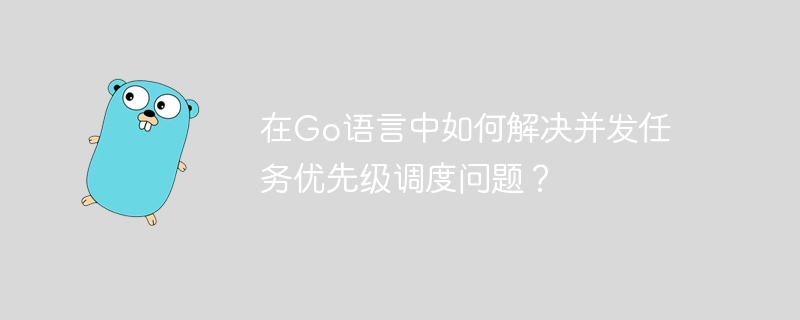Home >Backend Development >Golang >How to solve the problem of concurrent task priority scheduling in Go language?
How to solve the problem of concurrent task priority scheduling in Go language?
- WBOYWBOYWBOYWBOYWBOYWBOYWBOYWBOYWBOYWBOYWBOYWBOYWBOriginal
- 2023-10-08 20:09:111449browse

How to solve the problem of concurrent task priority scheduling in Go language?
In daily development, we often encounter the problem of concurrent task priority scheduling. For example, when we need to handle multiple tasks at the same time, some tasks may be more important than others and need to be executed first. In Go language, we can solve this problem by combining goroutine and channel.
The goroutine of the Go language can easily execute multiple tasks concurrently, while the channel provides a communication mechanism between multiple goroutines. By using goroutines and channels, we can implement priority scheduling to ensure that important tasks can be processed first.
Next, let us use an example to understand how to solve the concurrent task priority scheduling problem in the Go language.
Suppose we have three tasks A, B and C. Task A has the highest priority and needs to be executed first. We can create three goroutines to perform these three tasks, and then use a channel to notify the main goroutine of the completion of the task.
First, we define a task structure, including the name and priority of the task:
type Task struct {
Name string
Priority int
Completed bool
}Then, we create a goroutine to execute task A. In this goroutine, we can use time.Sleep() to simulate the execution of tasks:
func taskA(ch chan<- Task) {
fmt.Println("Executing task A...")
time.Sleep(time.Second)
task := Task{Name: "A", Priority: 1, Completed: true}
ch <- task
}Next, we create two goroutines to execute task B and task C. Similarly, we use time.Sleep() to simulate the execution of the task:
func taskB(ch chan<- Task) {
fmt.Println("Executing task B...")
time.Sleep(time.Second * 2)
task := Task{Name: "B", Priority: 2, Completed: true}
ch <- task
}
func taskC(ch chan<- Task) {
fmt.Println("Executing task C...")
time.Sleep(time.Second * 3)
task := Task{Name: "C", Priority: 3, Completed: true}
ch <- task
}Finally, we receive the task completion notification through the channel in the main goroutine and process it according to the task priority:
func main() {
ch := make(chan Task)
go taskA(ch)
go taskB(ch)
go taskC(ch)
for i := 0; i < 3; i++ {
task := <-ch
fmt.Printf("Task %s completed.
", task.Name)
}
} In this example, we first create a channel with a length of 3 to receive notification of task completion. Then, we created three goroutines to execute task A, task B and task C respectively. In the main goroutine, we use a for loop to receive notification of task completion from the channel and output the name of the task. Since we use time.Sleep() in the task's goroutine to simulate the execution of the task, in the output result, task A will be completed first, followed by task B, and finally task C.
In this way, we can implement concurrent task priority scheduling in the Go language. If there are more tasks, we can create more goroutines according to the priority of the tasks and use more channels in the main goroutine to receive notifications of task completion. This approach ensures that important tasks can be prioritized and improves system efficiency and response speed.
To sum up, the combination of goroutine and channel can effectively solve the problem of concurrent task priority scheduling. By properly allocating goroutines and using channels for communication, we can achieve priority scheduling of tasks and ensure that important tasks can be processed first. This method is not only simple and efficient, but also easy to understand and implement. In the Go language, we can make full use of the features of goroutine and channel to make concurrent programming simpler and more reliable.
The above is the detailed content of How to solve the problem of concurrent task priority scheduling in Go language?. For more information, please follow other related articles on the PHP Chinese website!

